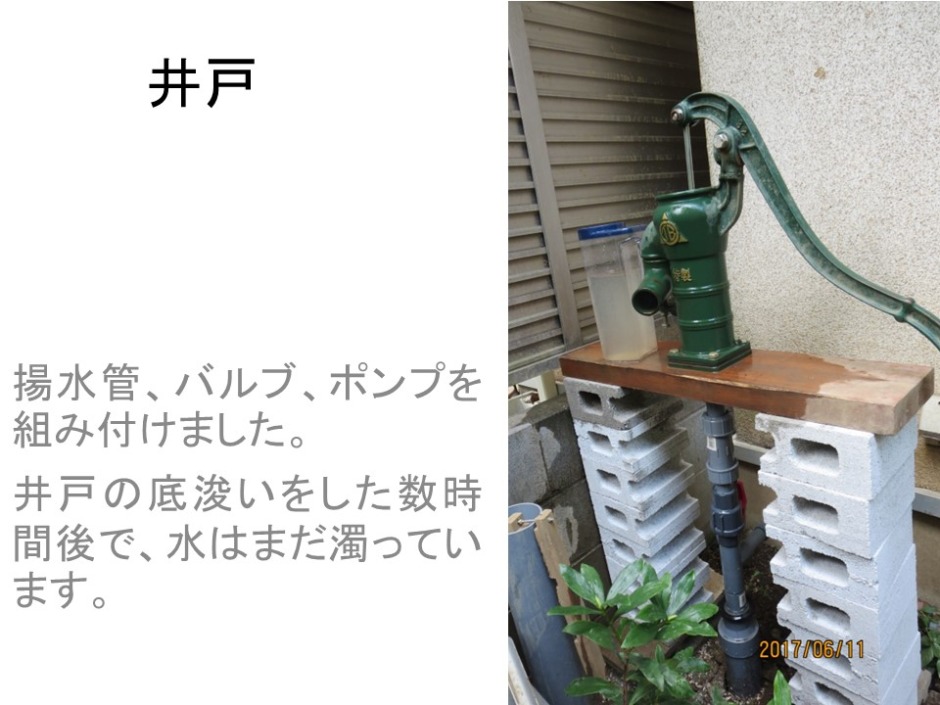
A well I dug at my house. I've included a photo and explanation.
Professor Faculty of Science and Engineering Toshiyuki Monma
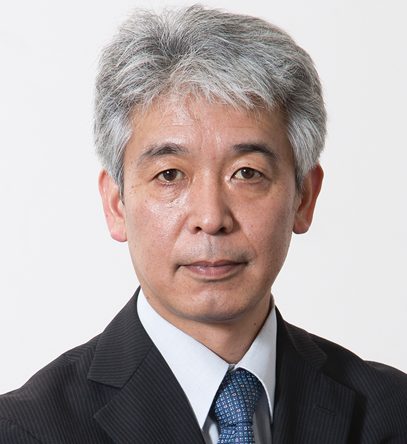
D. in Engineering from Waseda University School of Science and Engineering. D. in Engineering from Waseda University School of Science and Engineering Research Associate and a postdoctoral fellowship at the University of Minnesota, USA, before joining Waseda University Faculty. Specialized in electrochemistry. Development of battery and sensor material systems and electrochemical measurement methods.
From time to time, I am asked about my hobbies in the self-introduction section. Every time, I struggle with what to write. I am researching interesting subjects in the sense that I will pursue something for 5 or 10 years, but since it has become work, I cannot call it a hobby. However, although the content is different each time, there are things and subjects that I am interested in and absorbed in for periods of several months to several years.
Thinking back, I studied the principles of aquarium filters, made and improved them, while hatching and cultivating killifish and marsh shrimp (for several years). At a time when many Japanese people became concerned about the amount of radiation in the environment, I researched cloud chambers, made a prototype using items I had at home, and actually saw that lines of mist were created (for 2 weeks?). There have been many other changes, but basically, I continue to look into things that interest me and ask myself, "Why? How does it work? Does it really work that way?", and when I feel like trying something myself, I try it out or make it myself.
After playing with the cloud chamber, during the planned power outages, I bought a gasoline generator and, while I was there, I was reviewing the mechanism of a carburetor that I had learned at a driving school, making the excuse that I was disassembling and servicing it. Around that time, the news came out that some radiation had been mixed into the water supply in Tokyo. I believed that in the event of a disaster that would stop the infrastructure, it was important to have not only energy but also water at home, so I became interested in wells.
While looking at information on wells on the Internet, I found a book written by someone who had dug a well by himself, and luckily I was able to borrow it from a nearby library. By reading the book and collecting information from other people who had done it before, I was able to deepen my understanding of how to dig the ground, learn about the conditions for groundwater to exist, and investigate the formation of the land I live on tens of thousands of years ago and the altitude of nearby springs. Using columnar diagrams that I had and those that were publicly available, I came to the conclusion that if I dug in my small garden of about 10 square meters in size, I should be able to find groundwater.
I realized that I could make a digger that can dig vertically into the soil several meters by purchasing PVC pipes and pipes of different diameters, so I learned about PVC adhesives and made a prototype digger (it took about two weeks to conceive, gather materials, and make it), and started digging an 89mm diameter hole in the garden. The digging process was a repetition of simple tasks, and it was also a time to think about various things. When materials or tools occasionally fell, I panicked for a moment, but then I had fun thinking about how to get them out of the bottom of this narrow, deep hole, making props to deal with the situation, like a puzzle.

After several hours of work on the weekends, sunny and rainy, and digging smoothly from the topsoil to the Kanto Loam layer, I suddenly couldn't dig any more. After trying again and again, a clay-like substance started to come up. "Yes, it's clay!" I was delighted and bought an old-fashioned hand pump. I connected the pipe and moved the handle of the pump up and down several times after priming it. At first, it was muddy water, but after going up and down several times, the color gradually became lighter. So I got greedy and tried to reach the groundwater below the clay, so I improved the digger and worked hard to dig out the clay. Before long, the color of the clay that came up changed from ochre to green-blue. My workplace is convenient, and when I reported the color to Professor in my department who should be knowledgeable about clay, he instantly gave me his thoughts and I immediately agreed that the underground atmosphere was reducing. I had fun, and somehow managed to break through the clay layer, and gravel and sand started to come up.
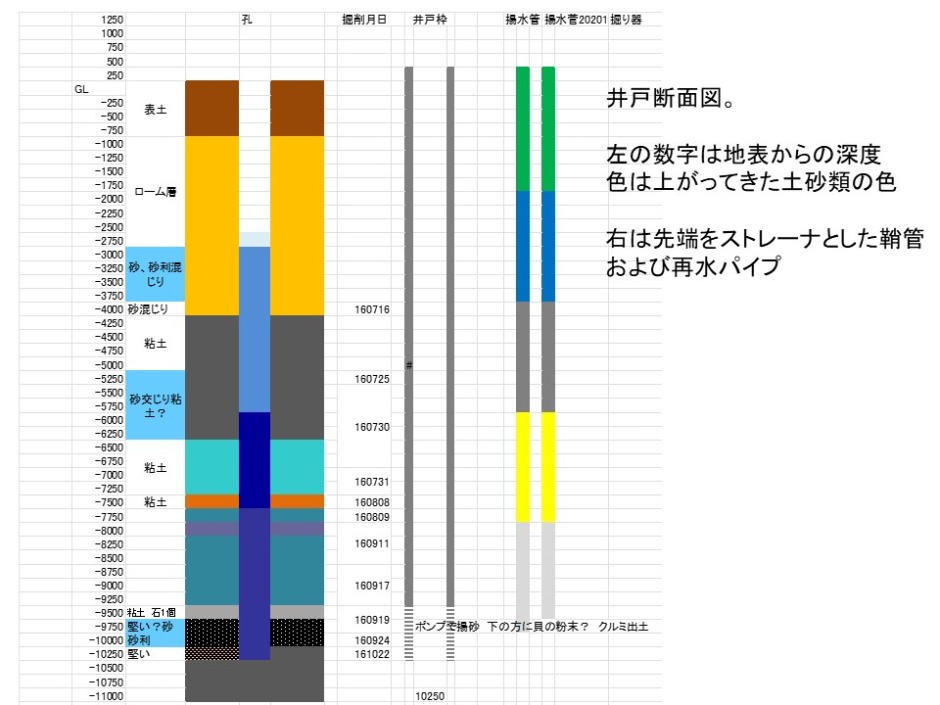
It was a project I started in early summer, or rather, adult mud play, but I slacked off during the cold season, and before I knew it, a year had passed. When I resumed work, the gravel and sand were not coming up as much, and finally it became a hard layer and I could not dig any further. Partway through, I also introduced an electric well pump and installed piping from the pump to the faucet, and when I finished, I toasted myself alone.
After consulting with the health center and learning from the results of a water quality test that the water was safe to drink after boiling or simple disinfection, my interest in digging a well quickly faded and I now use it simply as a convenient item. I use it to water water at about 16°C throughout the year, with no costs other than the electricity for the pump, and to water sprinklers in the summer and melt the occasional snowfall, but it can also be used as is to change the water in my freshwater fish tank, so it's very useful. In addition, as a plaything, I also use it to water the outdoor unit of an air conditioner on a hot summer day and to dry mist the small garden. I think I'll have to ask my friend to return the digger I lent him when I dredge for maintenance in the future.
In this mud play project, in addition to doing some simple woodworking, we learned about Article 237 of the Civil Code and the origins of the Japanese land. On my desk right now is a walnut shell that I found while digging in the gravel layer, and I sometimes think about using a mass spectrometer (MS) to measure its age.
I think everyone enjoys learning more about, understanding, and experiencing things that interest them. If you find yourself interested in something, I encourage you to dig deep into it until you are satisfied. It's fun.


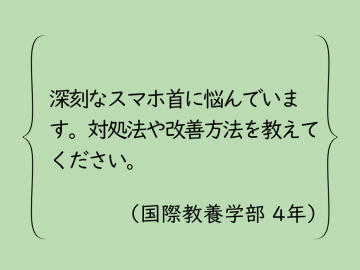

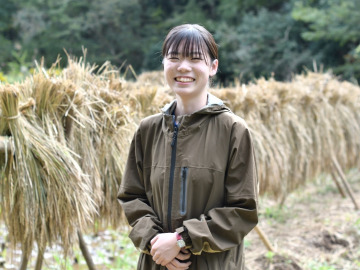
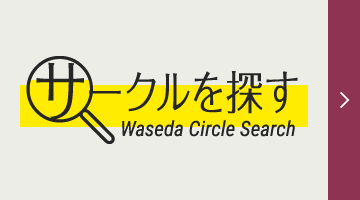
![[Save version] Map of the four main campuses](https://www.waseda.jp/inst/weekly/assets/uploads/2025/09/17cb2975123fc5103172ef60bd98608d-610x458.jpg)

